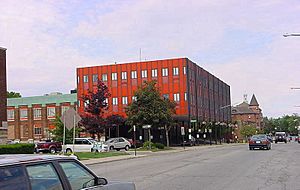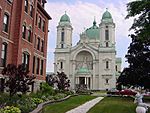Lackawanna, New York facts for kids
Quick facts for kids
Lackawanna
Lèkaohane (Delaware)
|
|
|---|---|

Lackawanna's Orange City Hall
|
|

Location of Lackawanna in Erie County and New York
|
|
| Country | United States |
| State | New York |
| County | Erie |
| Named for | Lackawanna County, Pennsylvania |
| Government | |
| • Type | Mayor-Council |
| Area | |
| • City | 6.60 sq mi (17.09 km2) |
| • Land | 6.55 sq mi (16.96 km2) |
| • Water | 0.05 sq mi (0.13 km2) |
| Elevation | 623 ft (190 m) |
| Population
(2020)
|
|
| • City | 19,949 |
| • Rank | NY: 35th (2010) |
| • Density | 3,046.58/sq mi (1,176.36/km2) |
| • Metro | 1,254,066 |
| Time zone | UTC−5 (EST) |
| • Summer (DST) | UTC−4 (EDT) |
| ZIP Code |
14218
|
| Area code(s) | 716 |
| FIPS code | 36-029-40189 |
| GNIS feature ID | 0954863 |
Lackawanna is a city in Erie County, New York, United States. It is located just south of Buffalo in western New York State. In 2020, the city had a population of 19,949 people. Lackawanna is one of the fastest-growing cities in New York. Its population grew by 10% between 2010 and 2020. It is part of the larger Buffalo-Niagara Falls metropolitan area.
The city's name comes from the Lackawanna Steel Company. This company owned the large steel plant where the city grew up. In the early 1900s, the Lackawanna steel plant was the biggest in the world. The word "Lackawanna" comes from the steel company's first location. This was in a river valley in Pennsylvania. The name might mean "sandy stream" or "forks of the river" in the Lenape language.
Contents
History of Lackawanna
Early Settlement and Town Formation
The area where Lackawanna is now was once part of the Buffalo Creek Reservation. This land was not open for people to settle until 1842. That year, the Seneca Indians sold the land. In 1851, a town called Seneca was created. Its name was changed to West Seneca in 1852. The area that is now Lackawanna was known as West Seneca or Limestone Hill back then.
The Steel Industry Era
Lackawanna was a major center for making steel for most of the 1900s. In 1899, the Lackawanna Steel Company bought land along the shore of Lake Erie. The company started building in 1900 and moved to the area in 1902. The steel plant began working in 1903. In 1909, the people living there voted to separate from West Seneca. This is how the city of Lackawanna was formed.
Most of the city's workers were employed by the Lackawanna Steel plant. So, city life often centered around what happened at the mill. Workers tried to form a labor union several times. This sometimes led to conflicts. For example, in 1910, a strike was ended by police. In 1919, steel workers formed a union again. They joined a big national strike. Other nearby companies also went on strike to show support. After another strike in 1941, the CIO finally made a deal for the steel workers.
In 1922, the Bethlehem Steel Company bought the Lackawanna Steel Company. The Bethlehem Steel plant grew to be the largest in the world at one point. This growth also led to the city's continued growth. At its busiest, the plant employed 20,000 people. Many immigrants came to Lackawanna to work and live.
Decline and Redevelopment
Later in the 1900s, the steel plant faced problems. It also had to pay more property taxes to the city. Because of these issues, the steel plant's business went down. It finally closed in 1983, and many people lost their jobs.
In the 2000s, people have worked to reuse the old steel plant land. This land is called a brownfield because it was used for industry before. Now, different businesses use the site. Some use the old steel plant buildings, and some are in new buildings. There are ongoing studies about whether the land is safe.
As part of the redevelopment, wind turbines were built on the former Bethlehem Steel property in 2007. These eight large turbines make power for many homes. They are seen as a way to create clean energy.
The Buffalo Harbor South Entrance Light is an important historical building. It was added to the National Register of Historic Places in 2007. In 2016, a large fire happened at the old Bethlehem Steel complex.
Railroads and Notable Court Case
The Delaware, Lackawanna and Western Railroad operated from 1851 to 1960. It then joined with another railroad to become the Erie Lackawanna Railway. This railway ran until 1976.
The city of Lackawanna was part of an important court case in 1971. It was called Kennedy-Park Homes Association v. City of Lackawanna. The court decided that the city government could not stop a new housing project. This project was for people with lower incomes. The court said stopping it would be unfair based on race.
The Lackawanna Six Incident
A group known as the Lackawanna Six were accused of traveling to Afghanistan and Pakistan in 2001. They were arrested in Lackawanna in 2002. This event brought a lot of attention to the city. It affected the city's image for a while, but Lackawanna is now recovering.
Geography of Lackawanna
Lackawanna covers about 6.6 square miles (17.1 square kilometers). A small part of this area is water. The city is located on Lake Erie. However, the old Bethlehem Steel plant takes up most of the waterfront. Smokes Creek runs through the city and flows into Lake Erie. This creek is named after a Seneca Indian Chief named Sayenqueraghta, who was called "Old Smoke."
Abbott Road is a main road that goes north and south through the city. Ridge Road is a main road that goes east and west.
Neighboring Areas
Lackawanna is next to several other cities and towns:
- City of Buffalo to the north
- Town of West Seneca to the east
- Town of Orchard Park to the southeast
- Town of Hamburg to the south
- Village of Blasdell to the south
- Lake Erie to the west
Main Roads

 Interstate 90 (the New York State Thruway) passes through the very southeastern part of the city.
Interstate 90 (the New York State Thruway) passes through the very southeastern part of the city. U.S. Route 62 (South Park Ave.) goes north and south through the city.
U.S. Route 62 (South Park Ave.) goes north and south through the city. New York State Route 5 (Fuhrmann Blvd., Hamburg Tprk.) is a busy road that goes through the city.
New York State Route 5 (Fuhrmann Blvd., Hamburg Tprk.) is a busy road that goes through the city.
Population and People
| Historical population | |||
|---|---|---|---|
| Census | Pop. | %± | |
| 1910 | 14,549 | — | |
| 1920 | 17,918 | 23.2% | |
| 1930 | 23,948 | 33.7% | |
| 1940 | 24,058 | 0.5% | |
| 1950 | 27,658 | 15.0% | |
| 1960 | 29,564 | 6.9% | |
| 1970 | 28,657 | −3.1% | |
| 1980 | 22,701 | −20.8% | |
| 1990 | 20,585 | −9.3% | |
| 2000 | 19,064 | −7.4% | |
| 2010 | 18,141 | −4.8% | |
| 2020 | 19,949 | 10.0% | |
| U.S. Decennial Census | |||
In 2000, there were 19,064 people living in Lackawanna. The city has a diverse population. Many different groups of people live there. Lackawanna also has a large Yemeni population.
Places of Worship
Lackawanna is home to many different places of worship. There are fourteen Protestant churches, ten Roman Catholic churches, and Saint Stephen Serbian Orthodox Church. It also has the Masjid Alhuda Guidance Mosque, which is the largest mosque in the Buffalo area.
Our Lady of Victory Basilica
Lackawanna's Our Lady of Victory Basilica is a very important church. It is considered a National Shrine. Next to the basilica is Holy Cross Cemetery.
Father Nelson Baker was a Catholic priest who did a lot for the community. He built a home for working boys in 1898. He also oversaw the building of a home for babies in 1907, a maternity home in 1915, and Our Lady of Victory Hospital in 1919. He also built the Basilica of Our Lady of Victory in 1926. Father Baker named the basilica after a famous church in Paris. He was in charge of these places until he died in 1936 at age 94.
Father Baker's social programs have grown into Baker Victory Services. This organization helps over 2,500 children every day. Our Lady of Victory Hospital closed in 1999. It is now being turned into housing for older people.
The Catholic Church has recognized Father Baker as a "Servant of God." This is the first step toward him becoming a saint. In 1999, his remains were moved inside the basilica. In 2011, Pope Benedict XVI declared Father Baker "Venerable." His journey to becoming a saint continues.
Education
Public Schools
Children in Lackawanna attend schools in the Lackawanna City School District.
- Truman Elementary School: Pre-K to Grade 1
- Martin Road Elementary School: Grades K–5
- Lackawanna Middle School: Grades 6–8 (in a shared building)
- Lackawanna High School: Grades 9–12 (in a shared building)
The Global Concepts Charter School is a charter school. It offers education from Kindergarten through Grade 12. The school has two buildings. The K-8 building is at 1001 Ridge Road. The high school (grades 9–12) is at 30 Johnson Street.
Private Schools
Our Lady of Victory Elementary School is a private school. It is connected to the Roman Catholic Church. It teaches students from kindergarten through Grade 8.
Notable People from Lackawanna
Many interesting people have come from Lackawanna:
- R. J. Adams (also known as Bob Shannon), an actor and radio personality.
- Father Nelson Baker, a Catholic priest who built many charities and the Our Lady of Victory Basilica. He was known as the "Padre of the Poor."
- Ron Jaworski, a former professional football quarterback and sports broadcaster.
- Mike Mamula, a former professional football defensive lineman.
- Abdulsalam Noman, the first Yemeni-American elected to a city council in New York State.
- Connie Porter, an author known for her books for children and young adults. Her novel All-Bright Court is set in Lackawanna.
- Sayenqueraghta, a war chief of the Seneca tribe who lived near Smokes Creek.
- Ruben Santiago-Hudson, an actor and playwright. His musical Lackawanna Blues is set in the city.
- Dick Shawn, an actor, comedian, and singer.
- Dr. Lonnie Smith, an award-winning jazz organist.
- Margaret M. Sullivan, a journalist who worked for The New York Times and The Washington Post.
Images for kids
See also
 In Spanish: Lackawanna para niños
In Spanish: Lackawanna para niños







